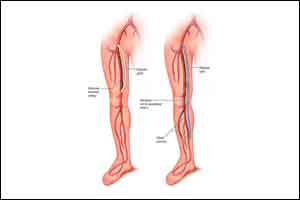- Home
- Editorial
- News
- Practice Guidelines
- Anesthesiology Guidelines
- Cancer Guidelines
- Cardiac Sciences Guidelines
- Critical Care Guidelines
- Dentistry Guidelines
- Dermatology Guidelines
- Diabetes and Endo Guidelines
- Diagnostics Guidelines
- ENT Guidelines
- Featured Practice Guidelines
- Gastroenterology Guidelines
- Geriatrics Guidelines
- Medicine Guidelines
- Nephrology Guidelines
- Neurosciences Guidelines
- Obs and Gynae Guidelines
- Ophthalmology Guidelines
- Orthopaedics Guidelines
- Paediatrics Guidelines
- Psychiatry Guidelines
- Pulmonology Guidelines
- Radiology Guidelines
- Surgery Guidelines
- Urology Guidelines
Exercise improves intermittent claudication leg pain on walking

People with intermittent claudication who participate in structured exercise programmes can walk about 80 meters further without experiencing leg pain than those who do not do the programme. They can also walk about 120 meters further overall.
Intermittent claudication is a cramp-like pain in the legs caused by narrowing of the arteries, which restricts blood flow to the muscles. There’s increasing evidence that maintaining physical activity can help. This updated systematic review combined data from 32 trials involving 1,835 adults with stable leg pain.
The quality of evidence was high for the main outcomes of how far people could walk in total and without pain. Exercises varied (for example, cycling, pole-striding) though most programmes were delivered at least twice weekly over three to 12 months.
The findings support NICE recommendations to offer supervised exercise programmes as the first-line approach for people with intermittent claudication.
Why was this study needed?
Many people over the age of 60 experience some degree of peripheral arterial disease, where there is narrowing or blockage of blood vessels supplying the legs and feet and about 4% can get claudication. This leg pain comes on with exercise and improves with rest (hence intermittent claudication). In most cases, it will not worsen, but blood supply to the limb becomes severely compromised for about one in five which can lead to amputation.
Intermittent claudication can cause people to reduce the amount they exercise which can further harm health and wellbeing. Many studies show that physical activity improves symptoms. Exercise programmes have been recommended by NICE for many years, but despite this uptake in the UK remains low.
This is the fourth Cochrane update on this topic, which adds two further trials to the existing evidence in support of these interventions.
What did this study do?
The updated systematic review included 32 randomised controlled trials assessing the effect of exercise programmes in 1,835 people with stable leg pain.
Most trials compared with usual care (excluding advice on exercise/walking) though a few compared with anti-clotting drugs or placebo tablets or interventions. Studies comparing different types of exercise, unsupervised exercise or vascular interventions were excluded. Exercises varied, including cycling, pole-striding, strength training, upper or lower limb exercises. Programme duration was mostly three to 12 months. All studies included at least two exercise sessions per week. The best-assessed walking distance or time by a treadmill test.
The most likely source of potential bias was researched staff being aware of group assignment, either at time of allocation or assessment. Six studies came from the UK.
What did it find?
- People who participated in exercise were able to walk on average 82 meters further without pain than those receiving usual care (95% confidence interval [CI] 72 to 92 meters). This was based on high-quality evidence from nine trials involving 391 participants with a follow-up time of six weeks to 24 months.
- They were also able to walk further in total than those in no-exercise groups (mean difference 120 meters, 95% CI 51 to 190). This was high-quality evidence from 10 trials in 500 participants.
- The trials were too small to measure any effect on deaths or amputations.
- There was a modest effect on quality of life (about two points on a 100 point scale).
What does current guidance say on this issue?
NICE guidelines on peripheral arterial disease diagnosis and management were updated in 2018. NICE recommend that all people with intermittent claudication are offered a supervised exercise programme. This is suggested to involve two hours of supervised exercise a week for a three month period, with people encouraged to exercise to the point of maximal pain.
Vascular intervention to open the obstructed arteries (angioplasty) is only recommended if a supervised exercise programme has not lead to a satisfactory improvement in symptoms, and other advice on controlling risk factors (e.g. smoking, diabetes) has been followed.
What are the implications?
This review adds support to the current NICE guidelines that people with intermittent claudication should be offered supervised exercise programmes before any consideration of invasive intervention. Another Cochrane review has also shown that supervised exercise improves walking distance compared to unsupervised exercise, such as simple advice from GPs.
It seems that not all eligible patients may be benefitting from this guidance, so this review should add weight to decision-making around providing these interventions.
The article was first published in NIHR.
For more details click on the link : DOI: 10.1002/14651858.CD000990.pub4

Disclaimer: This site is primarily intended for healthcare professionals. Any content/information on this website does not replace the advice of medical and/or health professionals and should not be construed as medical/diagnostic advice/endorsement or prescription. Use of this site is subject to our terms of use, privacy policy, advertisement policy. © 2020 Minerva Medical Treatment Pvt Ltd